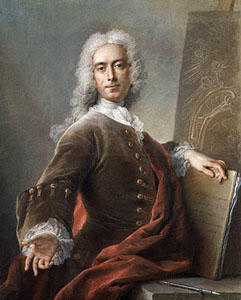• Describe the objects you see in this portrait. From the things you see surrounding this person, what do you think his job might be?
• This work is a self-portrait by the artist Charles-Antoine Coypel. What does the artist's posture and gesture communicate in this work? What do you think he wanted to communicate about himself in this self-portrait?
• The writing on the cover of the portfolio says, "Charles Coypel has painted himself for Philippe Coypel, his brother and his best friend, 1734." We know that Charles-Antoine's brother was the valet de chambre, or personal attendant, to King Louis XV. What reasons would Charles-Antoine have for wanting to create a portrait of himself for his brother Philippe?
• If you were going to create a self-portrait and dedicate it to someone in your family, who would it be and why would you choose him or her? What would you want to communicate about yourself? Think about where you might display your self-portrait. Who would you want to see it? |
Wearing the official academy costume—a brown velvet waistcoat, lace shirt, and long powdered wig—the French artist Charles-Antoine Coypel gracefully turns towards the viewer. When he made this half-length self-portrait, Coypel was forty years old and already a full professor at the Académie Royale in Paris.
With an open-handed gesture, Coypel presents both himself and his work to the viewer. He stands holding a portfolio containing colored paper; underneath, a silver holder contains sharpened pieces of chalk, the medium essential to his profession. In the background you can also see a sketch in chalk for a painting, The Entombment of Christ, a major public commission for a Paris church. Written on the portfolio is a dedication: "Charles Coypel has painted himself for Philippe Coypel, his brother and his best friend, 1734." Coypel's younger brother was a valet de chambre, or personal attendant, to King Louis XV, so the picture also served as a tool for self-promotion. Displayed in Philippe's house, the self-portrait would have boldly presented the confident image of Charles to the powerful members of the king's inner circle.
A brilliant portraitist, Coypel excelled in the medium of pastel. He first drew a detailed underdrawing lightly in pencil, then made crisp outlines using a sharpened pastel crayon. The soft, harmonious coloring completes the work and conveys the differences in texture between his thick velvet waistcoat, the gossamer white lace, and the smooth and shiny buttons.
About the Artist
Charles-Antoine Coypel enjoyed great success as a painter; his father, Antoine Coypel, who was also his teacher, was the premier peintre du roi (first, or official, painter to the king). Upon his father's death in 1722, Charles inherited the elder Coypel's painting and design responsibilities at court, became the chief painter of the duc d'Orléans (the title given to the brother of the king), and received lodgings at the Louvre (a royal palace at the time). He eventually became premier peintre himself in 1747, as well as director of the Académie Royale.
Besides talents in painting and engraving, Coypel possessed literary talent as well: he produced two tragedies, several comedies, prose, and some poetry. He also excelled as a tapestry designer for the Gobelins manufactory (the French Royal tapestry manufacturer); the twenty-eight scenes he created for the Don Quixote series (four of which are in the Getty collection), woven continuously between 1714 and 1794, were his most successful. He received several commissions for paintings for the palace of Versailles, and he worked for the king's mistress, Madame de Pompadour.
|
